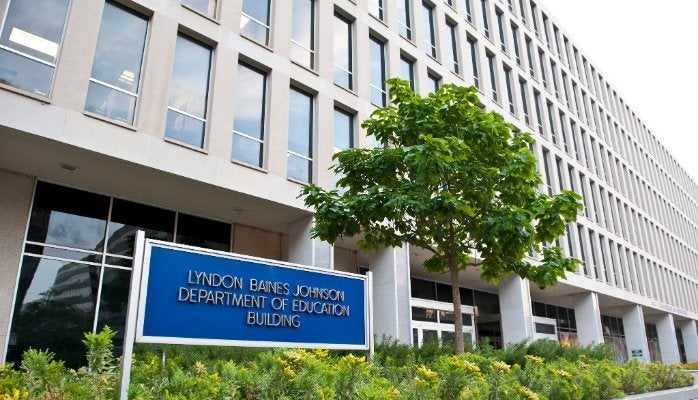
The new academic year is just getting underway and as millions of students flock to college campuses around the country, the first thing they’ll do before unpacking a dorm room box or stepping foot in a classroom is probably fret about how the heck they’re gonna pay for it.
It’s a concern that frustrates Congress and the U.S. Department of Education to no end. Higher education’s one of those things controlled by states, not the federal government, which means that despite an absolutely massive financial investment they have no real mechanisms to keep the prices institutions charge students in check. It says a lot that the most meaningful step Congress has probably taken in a decade to help keep costs down has been a tuition “shame list.”
If you haven’t heard of it or think it’s a joke, you’d be both forgiven and correct.
Higher education’s gambling problem
Education itself is actually remarkably cheap to produce. Anyone can go to a public library right now - or just open a web browser - and find the same materials found in nearly every subject taught in a college classroom. We don’t of course and instead spend thousands of dollars getting that education from a college or university because it’s the credential that labor markets ultimately value.
The price we pay for college education has a quality component that absolutely rankles policymakers. Introductory economics is introductory economics but in Michigan for example, Washtenaw Community College charges in-state students $94 per credit hour while Eastern Michigan University, which is just a couple miles down the road charges $323 per credit hour. Go just four more miles down the road and the University of Michigan in Ann Arbor charges the same undergraduate students a whopping $556 per credit hour.
At first glance that just seems absurd. We know low-cost 2-year institutions offer solid educations or else places like the University of Michigan wouldn’t accept transfer credits from places like Macomb Community College. So why do some places charge so much more than others for basically the same offering?
They do it because it costs a lot to lure as large a share as possible of the most prized faculty members and students. Rock-climbing walls, state-of-the-art residence halls and kitted-out laboratories look like excess but when these folks are being courted by two dozen peer institutions, the winning school is often the one offering them the most, not the least.
They also do it because students value, and are willing to pay for, access to all that talent. A degree might qualify someone for a job but having the opportunity to build lasting relationships with fellow students and faculty that can open doors after graduation can in some cases be worth more than the education itself. The larger the pool, the better the chances of making those kinds of connections.
Whether that networking opportunity is worth the gamble and price is a personal value judgment; it’s also not a guaranteed payoff but something that hinges on student effort more than institutional support. Like any investment, past performance doesn’t guarantee future results.
If you can’t beat ‘em...
What policymakers want is for colleges to deliver University of Michigan-caliber degrees at Macomb Community College prices without recognizing that tuition pays for different things at these two schools.
The traditional way for students to beat the system has been to start at a 2-year college and transfer to a 4-year one, except transferring students routinely lose credits in the process and end up having to take duplicative courses at the higher tuition rates. Colleges also limit the number of transfer credits they’ll accept and courses that logically transfer to one school can strangely not end up transferring to another. It’s not surprising that only about 1 in every 5 students who plan the 2-year/4-year degree path ends up doing so.
Still, the transfer model shows that what’s holding back low-cost education options is the relatively low value placed on their degrees and it’s here where the federal government has the opportunity to flex some muscle to keep college tuition in check. There’s no need for price controls or shame lists; all it needs to do is let the U.S. Department of Education join the fray of providers able to grant degrees.
They wouldn’t need to offer a single class. All they’d have to do is define degree programs they want to offer by a bundle of courses, create a registry of eligible courses existing institutions (or third-party providers) already offer, let students submit proof of completion and grant a degree. Students could complete all of their credits at one institution or mix and match classes from several different providers.
If it seems crazy, it actually isn’t. Degree requirements are similar across schools but not uniform. There’s nothing to prevent the Department from establishing its own requirements, within bounds, for what it believes meets the standard for a certificate, associates or bachelor’s degree in any field it wants to offer. That it may be only marginally different than what any particular college currently requires isn’t beside the point. It is the point.
A degree’s value is driven largely by how labor markets perceive its worth and the Department of Education has the unique ability to leap the quality hurdle and create a reputable credential that new entrants to the higher education space typically can’t. After all, these are the same folks who determine whether an institution’s students are eligible for federal student aid based on quality metrics; I mean, they’re the ones who officially recognize the accreditors that set the standards for college quality.
All that needs to happen is for employers and consumers alike to believe that the federal government knows a good degree program when it sees one. If we sincerely think the U.S. Department of Education isn’t able to do this then our system has much bigger problems.
A little competition never hurt anybody
There will still be students willing to pay the financial price and degree requirement premiums to get a university’s degree rather than the government option and that’s a good thing. Where the quality bump is there or students want to buy access to potential networking opportunities, we should ensure they have the option and in return expect them to pay the price for it.
Where it isn’t though and students end up just buying an education, having a low-cost/high-quality government degree available puts enormous pressure on colleges to compete on price. Unless cost increases translate into better graduation rates or better employment opportunities, colleges would have to focus on delivering low-cost education or run the risk of losing students to providers that do.
Community college enrollments would, and should, obviously benefit, while for-profit institutions would probably need to re-evaluate their entire business model in order to stay price competitive. Still, other low-cost for-profit education providers (thinkStraighterline), would likely flourish, especially since their online structure reduces consumer costs even further by stripping away the absurd, airline-style fees that schools charge students on a semester basis.
If anything it opens up the door to a range of alternative education providers, even adjunct faculty members, that could use the Department’s registry as a guideline for developing no-frills courses that would qualify towards a government degree. As more providers sell more low-cost education opportunities, institutional degree programs would have to either cut costs or convincingly justify students and families that they’re worth the price.
Seeing the forest for the trees
It’s easy to offhandedly dismiss a proposal like this since it departs radically from the norm and because it requires a great deal of thought about things like where the Department’s degree-granting flexibility would start and end, as well as how federal financial aid should be distributed. At a certain point though we need to accept that the tinkering of the past 20 years hasn’t gotten us anywhere.
A fresh president just around the corner, and some likely churn in Congress and at the Department of Education means now’s as good a time as ever to start tackling big problems by proposing and thinking about big solutions.
@EDAnalyst
Note (1): this piece was first published on LinkedIn on 8/28/2016
